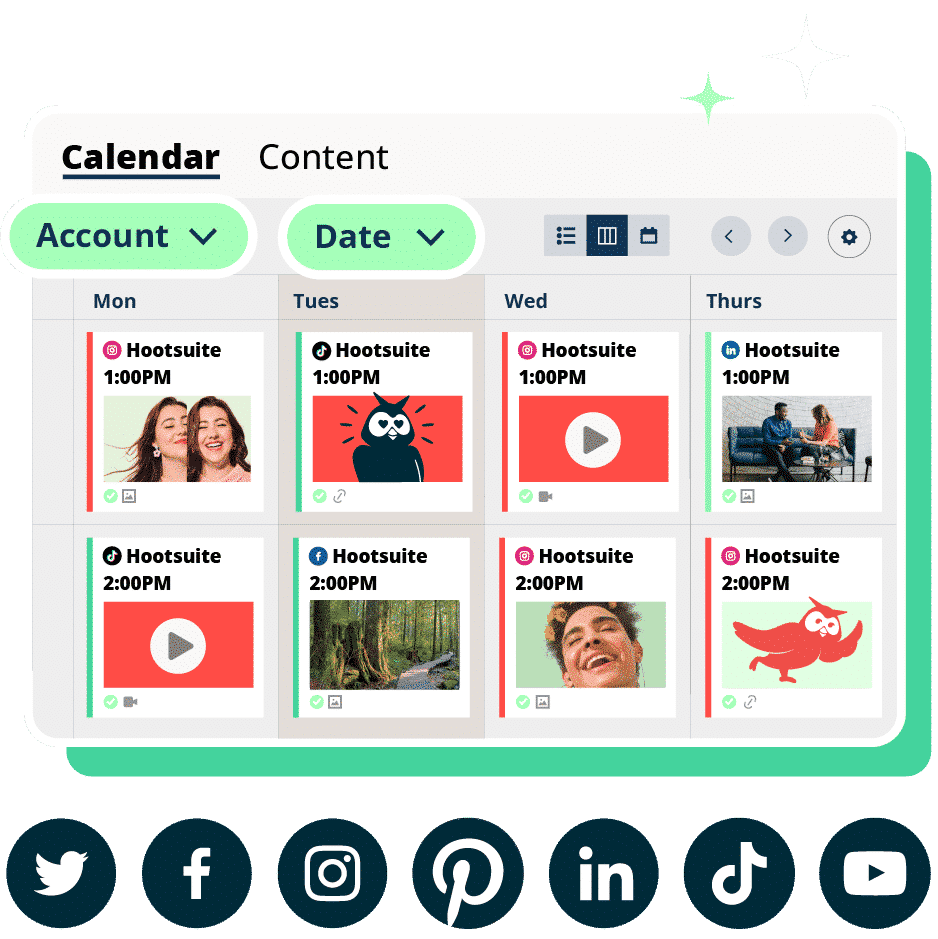Your engagement rate is one of the most important metrics for tracking your social media performance. It can reveal audience preferences, guide your content strategy, and help you prove the value of your social marketing work to the people who control the corporate purse strings.
Unfortunately, engagement calculations can seem a little mysterious. Where do you get the data from? What’s the correct formula to calculate engagement rate? And what is a good benchmark to aim for?
Fortunately, we’ve got answers to all those questions right here in this post. It’s not as complicated as you might think!
Keep reading for a free calculator — and for industry-specific benchmarks across all major social networks.

Key Takeaways
- Engagement rate measures how much an audience interacts with social media content relative to reach or audience size. It includes likes, comments, shares, saves, and other actions — but excludes views.
- High engagement rates reflect audience interest and build trust with first-time visitors to a social profile. They also signal quality to social media algorithms and can result in higher organic visibility.
- There are various formulas to calculate engagement, such as by reach (ERR), post (ER post), impressions, and more. Social media analytics tools help automate these calculations and provide industry benchmarks for comparison.
What is engagement rate?
Engagement rate is a social media metric that measures how much of your audience actively engages with your content. It defines the amount of interaction a piece of content (or a campaign, or a whole account) gets compared to reach or audience size.
Why is engagement important? First off, comments, shares, saves, likes, and other actions that count towards engagement prove your content resonates with your audience.
Second, higher engagement rates help you get better visibility on social media platforms. That’s because social algorithms surface more engaging content to new audiences.
A lot of engagement on your content also makes you look more trustworthy and appealing to first-time profile visitors, especially if there’s active conversation happening in your comments.
So what exactly do we mean when we talk about “engagements”? The specific engagement metrics vary by channel, but in general you want to include any action a social media user takes to interact with your content.
So, views don’t count as engagement, but likes, comments, shares, saves, poll and question responses, messages, and link clicks all do.
Free engagement rate calculator
As you’ll see below, there are several ways to calculate your social media engagement.
Unfortunately, they all involve math. (Unless you have an analytics tool that calculates engagement rate automatically, like Hootsuite Analytics!)
Fortunately, we’ve created this free engagement rate calculator to do that math for you. You just need to plug in some basic information about your posts.
Tip: You can use this free tool to calculate your account’s overall engagement rate, the engagement rate of a specific campaign, or the engagement rate for a specific time period.
For overall engagement, include information about all your posts (e.g., total number of posts published, total number of likes and comments, and so on).
For a specific campaign, only include the details of the posts that were part of the campaign. Same goes for a specific timeframe.
If you’re looking for a more detailed engagement analysis or you want to calculate different kinds of engagement, download our free spreadsheet calculator. It will still do the math for you, but it’s got space for a little more complexity.
Or, better yet, start a free 30-day Hootsuite trial to track the engagement rates for all your social channels in one place. Hootsuite Analytics collects your stats and provides engagement data for your accounts on Facebook, Instagram, X (Twitter), LinkedIn, Pinterest, and TikTok.
With Hootsuite Analytics, you can also:
- Find out when your audience is online and get personalized recommendations for your best times to post for each of your accounts specifically based on when your audience is most likely to engage.
- View industry engagement rate benchmarks and see how you compare to competitors (so you have a better understanding of what is a good engagement for your industry).

How to calculate engagement rate: 6 formulas
First, a moment of levity before diving into the math.
We feel seen, @instagramforbusiness.
So that you never have to feel this way again, here are the most common formulas you’ll need to calculate engagement rates on social media.
1. Engagement rate by reach (ERR): most common
This is the most common engagement rate formula. ERR measures the percentage of people who interact with your content after seeing it.
Here’s how to use this formula to calculate engagement rate for a single post:
ERR = total number of engagements on a post / reach of that post * 100
To determine the average engagement of a series of posts, add up the all the ERRs from those posts and divide by number of posts:
Average ERR = Total ERR / Number of posts
In other words: Post 1 (3.4%) + Post 2 (3.5%) / 2 = 3.45%
Pros: Reach can be a more accurate measurement than follower count now that social media is officially in its algorithm era. Not all your followers will see all your content. And non-followers may see your content based on searches, shares, and hashtags, as well as the ever-powerful content recommendation engines. .
Cons: Reach can fluctuate for a variety of reasons, making it a different variable to control. A very low reach can lead to a disproportionately high engagement, and vice versa, so be sure to keep this in mind.
2. Engagement rate by post (ER post): best for specific posts
This formula replaces reach with followers, which is generally a more stable metric that makes post-by-post comparison easier. Most social media influencers calculate their average engagement this way.
ER post = Total engagements on a post / Total followers *100
To calculate the average, add up the engagement rates of all the posts you want to average, and divide by number of posts:
Average ER by post = Total ER by post / Number of posts
Example: Post 1 (4.0%) + Post 2 (3.0%) / 2 = 3.5%
Pros: This formula offers a more accurate measure of post-by-post engagement if your reach tends to fluctuate.
Cons: This formula may not provide the full picture since it doesn’t account for viral reach. Make sure to view this stat alongside follower growth analytics, as you can expect this engagement rate calculation to go down as your follower count goes up.
3. Engagement rate by impressions (ER impressions): best for paid content
First, let’s clear up the difference between reach and impressions. Reach, which we used in the first engagement rate formula, measures how many unique accounts see your content.
Impressions, on the other hand, measures how many times your content is displayed. If one person sees your post (or ad) three times, that will count as one reach but three impressions.
ER impressions = Total engagements on a post / Total impressions *100
Average ER impressions = Total ER impressions / Number of posts
Pros: This formula is an effective way of measuring the success of paid content, especially when you are using a CPM cost structure (cost per thousand impressions).
Cons: An engagement rate calculation that uses the number of impressions as the base is bound to be lower than ERR and ER post equations. After all, a user who sees the same post (or ad) three times is not likely to engage with it three separate times. Plus, like reach, impressions can be inconsistent.
4. Daily engagement rate (Daily ER): best for long-term analysis
Daily ER = Total engagements in a day / Total followers *100
Average Daily ER = Total engagements for X days / (X *followers) *100
Example: Say you have a total of 100 engagements in 10 days with 400 followers.
Formula: 100 / (10 *400) *100 = 100 / 4000 *100 = 2.5%
Pros: This formula is a good way to gauge how often your followers interact with your account on a daily basis, rather than how they interact with a specific post. As a result, it takes engagements on all posts into consideration – even content that was not posted during the period you’re evaluating. For example, if a new follower finds your account and likes some of your old content, this will still be included in this equation. This formula can also be tailored for specific use cases. For instance, if your brand only wants to measure daily comments, you can adjust “total engagements” accordingly.
Cons: There’s a fair amount of room for error with this method. For instance, the formula doesn’t account for the fact that the same follower may engage 10 times in a day, versus 10 followers engaging once. Like we said above, new followers can certainly do this! Daily engagements can also vary for a number of reasons, including how many posts you share. For that reason, it may be worthwhile to plot daily engagement versus number of posts.
5. Engagement rate by views (ER views): best for video
ER views = Total engagements on video post / Total video views *100
Average ER views = Total ER views / Number of posts
Pros: If one of your video’s objectives is to generate engagement, this can be a good way to track it.
Cons: View tallies often include repeat views from a single user (non-unique views). While that viewer may watch the video multiple times, they are not likely to engage multiple times.
6. Cost per engagement (CPE): best for influencer marketing or conversion-based campaigns
CPE = Total amount spent / Total engagements
Most social media ad platforms will make this calculation for you, along with other objective-oriented calculations, such as cost-per-click. Make sure to check which interactions count as engagements, so you can be sure you’re comparing apples to apples.
How to calculate engagement rate automatically
No matter which formula you use to calculate engagement rate, there’s a lot of manual effort in doing it yourself. Even with the free calculator included in this post, you still have to dig through your social media analytics to find all the relevant engagement data to plug in.
The good news is that you can avoid this work entirely using a social media management and analytics tool like Hootsuite. It allows you to analyze your social media engagement rate across social networks from a high level and get as detailed as you want with customized reports.
Here’s an example of what an engagement rate report looks like in Hootsuite. In addition to your overall post engagement rate, you can also see what types of content get the highest engagement rate (so you can make more of those in the future), and even how many people visited your website.

In Hootsuite reports, it’s super easy to see how much engagement you get over a period of time, what is being counted as an engagement for each network, and compare your engagement rates to previous time periods.
Pro tip: You can schedule these reports to be created and sent to your email automatically. You can also set them to show you the data in whatever format makes the most sense to you: graphs, charts, etc.
A great bonus is that with Hootsuite, you get to see when your audience is most likely to engage with your posts — so you can schedule your content to maximize engagement rate.
What is a good engagement rate? [benchmarks for Q1 2025]
For your own engagement rate data to be useful, you need to understand it in context. An engagement rate of 1% to 5% is generally accepted to be good. But, of course, this depends on many factors.
The three biggest factors that determine what is a high engagement rate are:
- Platform: You should expect variation in your engagement rate across platforms, and this can change over time. At the moment, TikTok has a generally higher engagement rate than Instagram.
- Industry: Fashion and entertainment will always see higher engagement rates than finance (except on LinkedIn). When evaluating your engagement rate, you need to compare with other accounts in your own industry.
- Follower count: In general, you can expect your engagement rate to go down as your follower count goes up. This is simply because smaller accounts have a more focused and passionate follower base.
The Hootsuite team partnered with data science agency Critical Truth for a comprehensive study. We analyzed over 1 million social posts — across industries and social networks — to bring you reliable benchmarks you can use in your strategic planning.
Keep reading for the most recent available data (collected in Q4 of 2024).
Construction, mining, and manufacturing
- LinkedIn: 3.3%
- Instagram: 2.8%
- Instagram Reels: 2.6%
- Facebook: 1.6%

Consumer goods and retail
- Instagram Reels: 2.1%
- Instagram: 1.8%
- Facebook: 1.2%
- X: 0.9%

Dining, hospitality, and tourism
- Instagram: 1.9%
- Instagram Reels: 1.7%
- Facebook: 0.9%
- TikTok: 0.6%

Finance
- LinkedIn: 2.3%
- Instagram: 1.8%
- Instagram Reels: 1%
- Facebook: 1.2%
- X: 1.1%

Government
- LinkedIn: 3.6%
- Instagram: 3.2%
- Instagram Reels: 2.3%
- Facebook: 2%
- X: 1.6%

Healthcare, pharma, and biotech
- LinkedIn: 2.8%
- Instagram: 1.6%
- Instagram Reels: 1.3%
- X: 1.3%
- Facebook: 1.3%

Media and entertainment
- TikTok: 2.1%
- Instagram Reels: 2%
- Instagram: 2%
- X: 1.7%
- Facebook: 1.3%

Non profit
- Instagram Reels: 2.6%
- Instagram: 2.2%
- Facebook: 1.8%
- LinkedIn: 1.7%
- X: 1.1%

Overall (all industries)
- LinkedIn: 2.8%
- TikTok: 2%
- Instagram: 2%
- Instagram Reels: 1.9%
- X: 1.6%
- Facebook: 1.4%

Real estate, legal, and professional services
- Instagram: 2.9%
- LinkedIn: 2.6%
- Instagram Reels: 2%
- Facebook: 1.8%
- X: 0.9%

More industries
Hootsuite has a built in benchmarking tool that allows you to compare your engagement rate to the average for your industry. You can use it to see graphs of how engagement rate for your industry has changed over time, so you always have an up-to-date understanding of engagement trends.

Don’t see the industry + platform combination you need here? Grab a free 30-day Hootsuite trial, and dig into data specific to your industry.
You now know how to measure your engagement rate. And you have a sense of the numbers you should be aiming for. So, what are the next steps?
You may simply need to provide the straight-up engagement rate numbers as part of your regular reporting to your boss, clients, or other stakeholders. In that case, you’re done!
But we would encourage you to go beyond simple reporting of the data. Your engagement rate provides a ton of insights about your audience, especially when analyzed over time.
Understanding what the numbers are telling you can help you build a stronger, data-informed content strategy. As you gain insights into what kinds of social brand behavior drive higher engagement, you can increase both your engagement rates and your ROI.
Here’s what that can look like for your team:
- Fill your content calendar with high-quality, engaging posts. Dive into your engagement rate analytics to see which types of posts work best on each platform. Over time you’ll identify patterns that can guide you to package winning ideas or lean into specific content formats.
- Find out what your audience and customers think. Tracking engagement data like comments, messages, shares, and mentions provides free business intelligence. Sure, this information tells you what your audience thinks about specific social posts. But thinking bigger, you’ll also see feedback on your products, branding, customer service, and more.
- Identify brand advocates. Your most engaged online fans may be good brand advocates to approach for sponsored deals and collaborations.
- Spot changing trends early. If you keep doing the same thing and your engagement rate changes significantly, that’s a clue that something is changing beyond your brand. Whether it’s a change in the algorithm or simply shifting audience preferences, you’ve got an early warning system in place to course correct from the start.
Save time managing your social media presence with Hootsuite. From a single dashboard, you can publish and schedule posts, find relevant conversions, engage the audience, measure results, and more. Try it free today.








